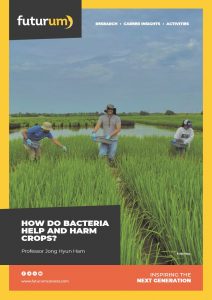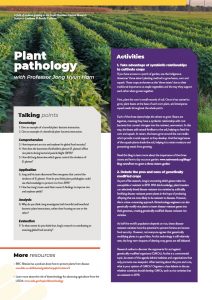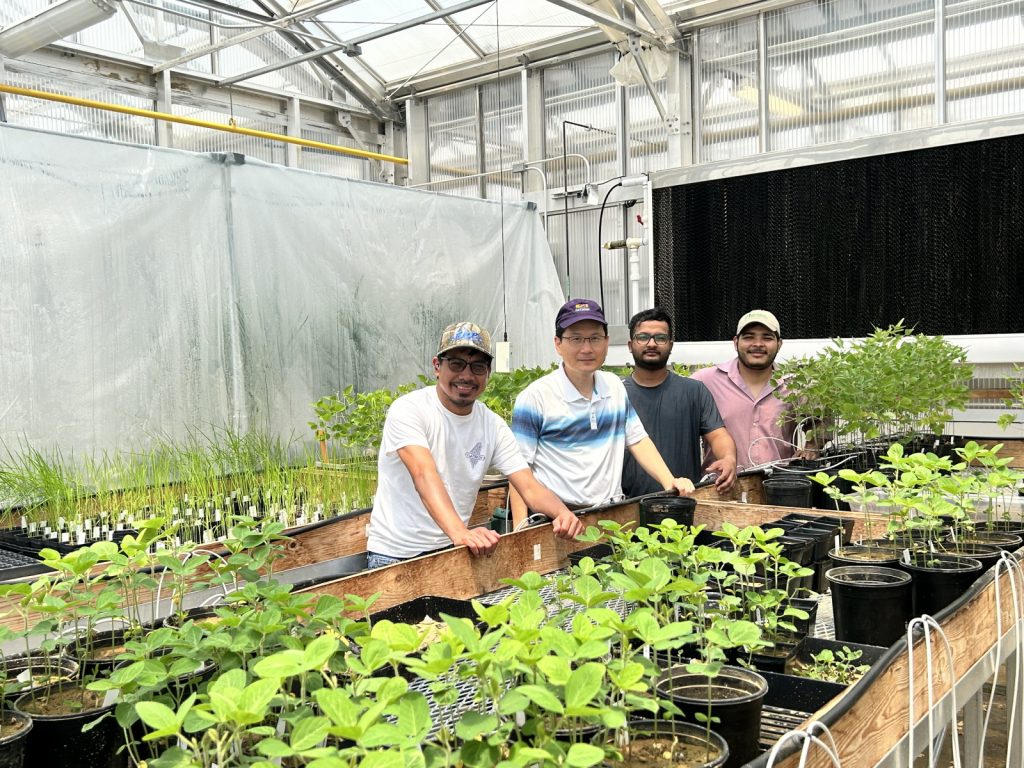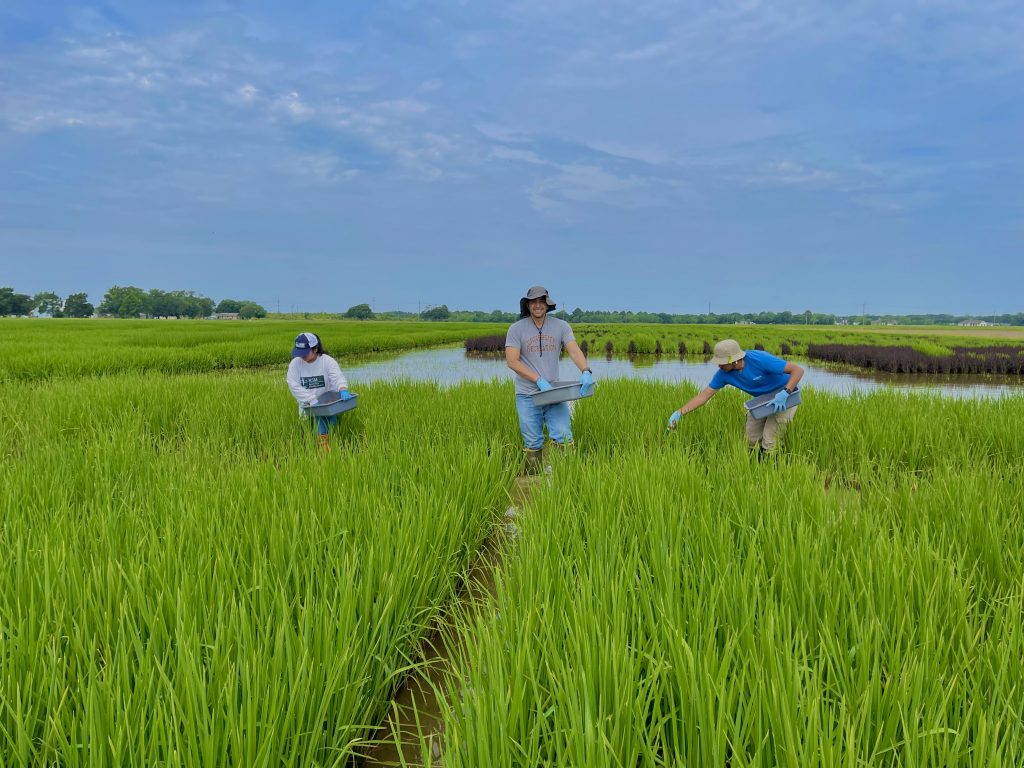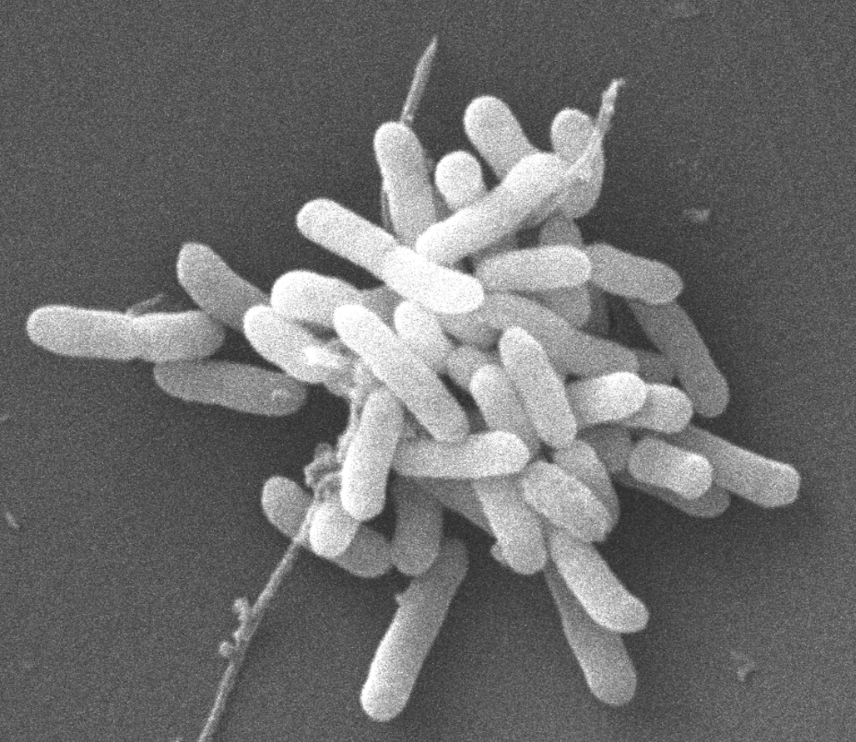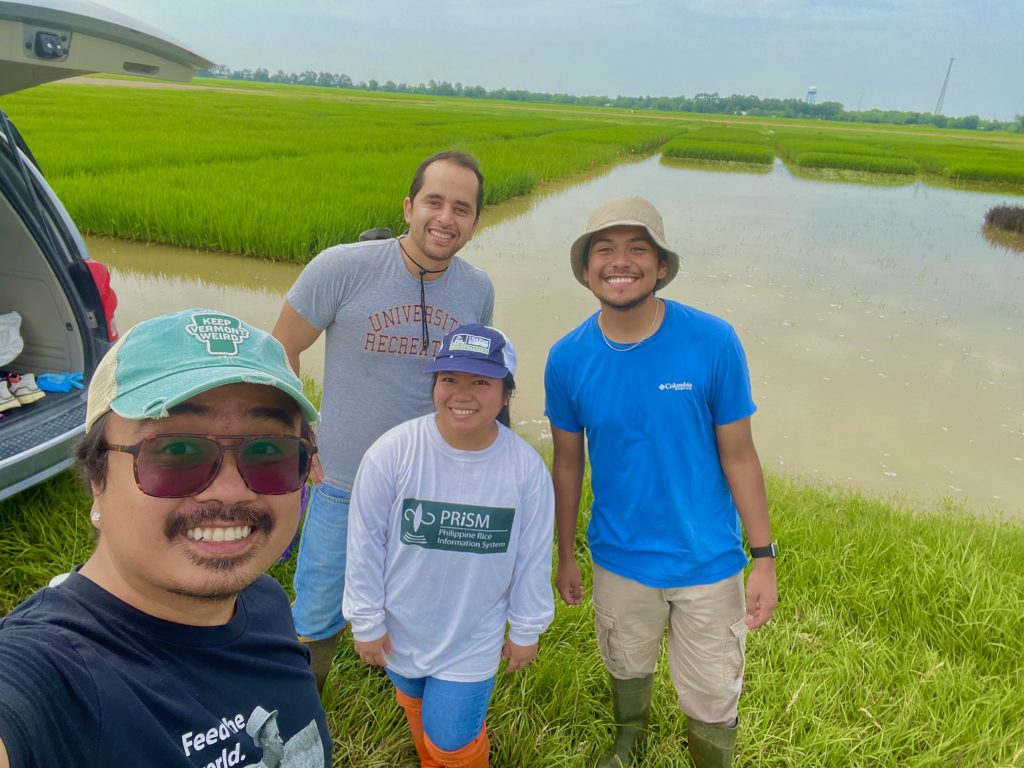How do bacteria help and harm crops?
Over half of the world’s population depends on rice as a staple food. However, some bacteria cause diseases that can drastically reduce rice harvests, potentially leading to famine. Meanwhile, other bacteria are beneficial for soybean plants, as they help produce important nutrients. Understanding how bacteria interact with plants is, therefore, essential for preventing plant disease and increasing crop yields. This is why, at Louisiana State University in the US, Professor Jong Hyun Ham is studying the impacts of bacteria on rice and soybean.
Talk like a plant pathologist
Bacterial panicle blight (BPB) — a disease caused by the bacterium, Burkholderia glumae, that attacks the panicles of rice plants, resulting in severely reduced crop yields
Genome — the complete set of genetic material in an organism
Legume — a plant from the family that produces seeds in pods, such as soybean, pea, bean and lentil
Microbe — a microscopic organism, such as a bacterium
Panicle — a branching cluster of flowers
Pathogen — a microbe that causes disease
Pathology — the study of diseases
Quorum-sensing — a form of cell-to-cell communication between bacteria
Recombinant DNA technology — the laboratory technique by which DNA molecules are broken apart and recombined
Symbiotic relationship — a close and mutually beneficial interaction between two organisms
Transposon — a segment of DNA that can be inserted into a gene
Virulence — the harmfulness of a pathogen
Rice and soybean are, respectively, the most important cereal and legume crops worldwide. “Over 50% of the world’s population depends on rice as a staple food,” says Professor Jong Hyun Ham, a plant pathologist at Louisiana State University. “It is also an important source of high-quality nutrients, especially to low-income people in developing countries, so its contribution to global food security is invaluable.” Soybean is a high-energy, high-protein crop that is indispensable as animal feed. Over three quarters of global soybean production is fed to animals, with the remainder used for tofu and soy milk for human consumption or converted into biofuels and petrochemical alternatives for industrial purposes.
How do soybean and rice interact with microbes?
Healthy soil is teaming with life. In fact, there about one billion microbes in just one teaspoon of soil! When these microbes interact with plants, the interactions may be beneficial, harmful or have no effect on the plant. Therefore, plant pathologists like Jong need to learn as much as possible about how plants and microbes interact with each other at the molecular level, to understand which interactions may lead to crop disease, how pathogens attack plants in these cases, and how the plants defend themselves. With this knowledge, scientists can develop disease-resistant crop varieties and other disease control strategies.
Soybean, like other legumes, has a symbiotic relationship with bacteria that live on the soybean roots. These bacteria are beneficial to the plant, as they convert nitrogen gas in the atmosphere into ammonium, a nutrient essential for plant growth. On the other hand, the bacterium Burkholderia glumae (B. glumae) has a harmful effect on rice as it causes bacterial panicle blight (BPB), a serious crop disease. The pathogen attacks the panicles of the rice plant, preventing the rice grains from developing. BPB can severely damage rice crops, reducing yields by up to 80%.
“Unfortunately, most of the popular rice varieties grown around the world are susceptible to BPB, and effective tools to control the disease, such as chemical products, are rarely available,” says Jong. “Thus, it is imperative to develop innovative strategies to control BPB based on better knowledge of the rice-bacteria interactions underlying it.”
What molecular techniques is Jong using to study B. glumae?
Jong and his team use various tools and techniques from molecular biology and genetics to study B. glumae and its interactions with rice. The genome of B. glumae contains thousands of genes, and Jong needed to discover which ones contribute to the bacterium’s virulence, or ability to harm rice plants, which it does by producing the toxin, toxoflavin. To do this, the team used a molecular biological tool known as transposon, a segment of DNA that can be inserted into the bacterial genome.
“Scientists can introduce transposon into a bacterial cell, where it will ‘jump’ into a gene in a random way, disrupting that gene’s genetic function,” explains Jong. “Using this characteristic of transposon, we generated a collection of mutants for almost every gene of B. glumae, except for the ones essential for the bacterium’s survival.”
Jong and the team then analysed all the mutant bacteria to determine whether they were producing more or less toxoflavin, which indicated whether they were more or less virulent than normal. “In other words, we examined whether toxin production was changed due to the disruption of the gene by transposon, indicating that that gene is important for toxoflavin production,” explains Jong. “The genes responsible for the altered virulence could be traced and identified from the transposon inserted in them.”
In addition, the team used recombinant DNA technology to delete certain genes from B. glumae, then observed how the bacterium functioned without them. If a mutated B. glumae had altered virulence, it suggested that the deleted gene played a role in controlling the bacterium’s virulence.
The team also studied the social behaviours, or collective actions, of B. glumae, as these interactions are important for understanding how BPB develops. Social behaviours of bacteria are determined by cell-to-cell communication, known as quorum-sensing, so Jong mutated different genes involved in cell signalling to examine which controlled B. glumae quorum-sensing.
What has Jong discovered about B. glumae?
Jong and his team have had great success investigating the biology of B. glumae and its impacts on rice. They have discovered five new genes that control the virulence of B. glumae, determined that the widely accepted model of B. glumae quorum-sensing was incorrect, and uncovered a key regulatory factor of B. glumae that determines its ability to cause BPB. “Because B. glumae cannot cause BPB without this regulatory factor, our next research direction is to find the chemical compounds and physiological conditions that can disable its function,” explains Jong.
How is Jong contributing to the development of disease-resistant crops?
As well as studying the bacterium itself, Jong and his team are investigating the genes in rice plants that prevent them developing BPB when exposed to B. glumae. Using genetic techniques, they have identified the location of disease-resistant genes on the rice genome and uncovered the DNA differences associated with disease resistance. “We have found and characterised several new genetic elements associated with rice disease resistance to BPB,” says Jong. “We have also developed numerous rice lines showing improved disease resistance to BPB.”
The team has characterised the molecular pathways that allow rice and soybean plants to resist bacterial diseases. However, not all plant-bacteria interactions are harmful to crops. Jong’s research is also focused on the beneficial interactions that could improve rice and soybean crop yields. “We have identified numerous beneficial bacterial organisms from various environmental conditions through multiple rounds of laboratory and greenhouse tests,” he explains. “These biological materials are the main focus of our research activities to formulate new products to enhance the growth and health of rice and soybean.” In addition to these beneficial bacteria, the team has successfully identified biochemical materials that, when applied to rice and soybean seeds, promote their growth and increase the disease resistance of the plants.
Reference
https://doi.org/10.33424/FUTURUM413
A scanning electron microscope image of B. glumae (each cell is about 2 microns long)
© Tiago Lelis
A field of soybean growing at the Doyle Chambers Central Research Station in Louisiana
© Rosalie Calderon
Thanks to the efforts of plant pathologists such as Jong, scientists are developing a better understanding of how to protect key crops from bacterial disease, and how to use beneficial bacterial to increase crop yields, hopefully resulting in improved global food security.
 Professor Jong Hyun Ham
Professor Jong Hyun Ham
Department of Plant Pathology and Crop Physiology, Louisiana State University Agricultural Center, USA
Fields of research: Plant Pathology, Phytobacteriology
Research project: Investigating the harmful and beneficial impacts bacteria have on rice and soybean
Funders: US Department of Agriculture – National Institute of Food and Agriculture (USDA-NIFA), Louisiana Rice Research Board, Louisiana Soybean and Grain Research and Promotion Board
About plant pathology
Plant pathologists study plant diseases and develop new ways to prevent, treat and manage them. These researchers are hugely important for addressing global issues such as food security and food safety. “Historically, plant diseases have had tremendous impacts on human society,” says Jong. “For example, ‘The Great Famine’ in Ireland during the mid-1800s was caused by potato disease, while the Bengal famine in India in 1943 was due to an outbreak of rice brown spot disease.” Plant pathologists across the globe are working in laboratories, greenhouses and fields to prevent and reduce the loss of life and economic impacts caused by plant diseases such as these. “I hope my research on bacterial pathogens and the genetics of rice disease resistance will lead to the development of more resistant rice varieties,” says Jong. “And I hope my research on beneficial bacteria will provide insights for the development of innovative disease management strategies for rice and soybean diseases.”
A day in the life of a plant pathologist
As a professor of plant pathology, Jong spends his time reading to learn more about the molecular mechanisms behind plant diseases, writing grant proposals to get more funding for his research, writing up the results of his work to share them with the scientific community and meeting with his team members to discuss their research projects. He also visits the team’s greenhouses and fields to monitor the plants growing there and conducts genetic experiments and molecular analyses in the laboratory.
What are the joys and challenges of the job?
“A great joy for me is discovering new things about the microbial world surrounding crop plants and plant defence systems,” says Jong. “I also enjoy meeting my laboratory members every morning to discuss our research projects and science in general.” But being a plant pathologist is not without its difficulties. “Unpredictable weather conditions are the most challenging part of field experiments,” says Jong. “We must also deal with various technical problems that occur during our laboratory research.”
Pathway from school to plant pathology
• As well as studying biology and chemistry at school, try to get practical experience of working with plants. If there is a local gardening group, botanical garden or horticultural society in your area, contact them to see how you could get involved to learn more about plant science.
• Contact the agriculture or biology departments at local universities to find out if they offer outreach opportunities for high school students. For example, Jong’s department at the LSU AgCenter runs youth development programmes that introduce students to agricultural skills and research: www.lsuagcenter.com/topics/kids_teens/programs
• At college or university, a degree in plant pathology, plant science, botany, agricultural science or horticulture could lead to a career in plant pathology. “Microbiology, genetics and biochemistry are essential subjects for understanding the principles of plant pathology,” says Jong, so take any courses offered in these areas. “Analytical chemistry, statistics, plant physiology, plant anatomy and organic chemistry are also strongly recommended if you want to conduct plant pathology research.”
• The American Phytopathological Society (APS) has a huge range of educational resources (www.apsnet.org/edcenter/foreducators), including information about different plant diseases, activities to try in class, a podcast (www.plantopiapodcast.org) and YouTube channel (www.youtube.com/user/plantdisease)
Explore careers in plant pathology
• As a plant pathologist, you could conduct experiments to uncover the molecular mechanisms behind plant diseases and develop disease-resistant crops at a university, for an agricultural biotechnology company or for a government agricultural agency.
• Learn more about the research conducted in the Department of Plant Pathology and Crop Physiology at Louisiana State University: www.lsu.edu/agriculture/plant
• The APS provides information about careers in plant pathology, including different roles in the field and advice from plant pathologists in different positions: www.apsnet.org/careers/careersinplantpathology
• Jong suggests visiting the websites of agricultural biotechnology companies such as Syngenta (www.syngenta.com), Corteva Agriscience (www.corteva.com) and Bayer (www.bayer.com/en/agriculture) to explore what they do. Many companies offer internships for students.
• The US Department of Agriculture (USDA) offers internships in different aspects of agricultural research: www.usda.gov/youth/career
Meet Jong
When I was younger, I was interested in natural sciences, including physics, biology, astronomy and geology. I was concerned about the future of humankind due to the rising issues of global food security and environment protection. These interests and concerns led me to study plant pathology.
I was inspired to pursue a career in plant pathology thanks to the experiences I had during my undergraduate studies. During my first year in college, I took a course in microbiology where I became fascinated by the fact that plants get diseases caused by microbial pathogens, just like humans and animals. And, while working in research laboratories, I was amazed to see how the pretty-looking cultures of fungi and bacteria could cause severe symptoms for the plants they infected. Most importantly, I was blessed to have great teachers and mentors at the early stages of my career.
I am proud that I am studying something very important but not very well known. Before studying plant pathology, I did not know that plants get sick from pathogen infections, or how severe the damages caused by epidemics of plant diseases can be. I am happy that my work can help farmers produce crops in more economically efficient and environmentally friendly ways. Moreover, it is a great pleasure to learn more about this world through studying how plants and microbes interact.
In my free time, I like reading and watching videos about physics, astronomy and philosophy. I also enjoy listening to and playing music, and at the weekend, I am actively involved in church activities.
Jong’s top tips
1. Get a good morning routine. I try to start my day at the workplace an hour ahead of my colleagues. Shaping yourself as a morning person is important for working in a laboratory, greenhouse or field, and it will help your productivity regardless of the career you choose.
2. Never finish anything without going through a proper reflection process. You will not always be successful in your work, but whether something was successful or unsuccessful, you should make a proper, written record. Otherwise, your results will be forgotten, and your time and effort will become meaningless.
Do you have a question for Jong?
Write it in the comments box below and Jong will get back to you. (Remember, researchers are very busy people, so you may have to wait a few days.)

